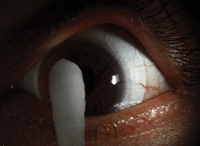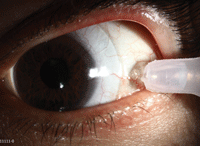 The more distressed the eye, the more mucous it produces in response to irritation and inflammation.
The more distressed the eye, the more mucous it produces in response to irritation and inflammation.
This normally innocuous reaction is a significant problem for those suffering from Graft-versus-host disease, ocular cicatricial pemphigoid and Stevens-Johnson syndrome, where the autoimmune disease attacks the mucous membranes. It can also pose a problem in post-corneal transplant patients and those with dry eye. This complication can interfere with contact lens wear—making the cure almost as annoying as the disease.
Scleral lenses offer patients excellent optics, increased comfort and ocular protection. Sclerals are often the only choice and/or treatment for very sick eyes. It’s not surprising, then, that mucous can drive scleral lens wearers—and fitters alike—absolutely crazy. Mucins, either deposited on the lens surface or trapped under the lens, can build up to the point of reduced vision—often markedly so.
 | |
|
Fig. 1. A stiff-handled cotton swab soaked in conditioner can be used to rub surface deposits off the lens.
|
What to do?
Oftentimes, I will hear doctors tell their patients to remove the lens, clean it and then reinsert it whenever the clouding bothers them. However, this practice is extremely disruptive to the patient’s day and, perhaps more importantly, I believe it drives a form of mucous fishing syndrome.1
This condition is a cyclical process caused by trauma to the conjunctive/goblet cells as the mucous is removed, which in turn induces more mucous production. Mucous, however, is not necessarily a bad thing—our bodies naturally produce it as a healing agent. However, when we disturb the mucous-producing goblet cells, they will produce ever-increasing amounts of mucin.
It has been my experience that folks who present with an initial extreme mucous build-up will reduce their mucous production over time by following these two simple steps. First, learn the techniques yourself, and then teach them to the patient so that they become self-reliant.

|
|
|
Fig. 2. Sodium chloride saline can be used to rinse out mucin trapped under the scleral lens.
|
2. Use a 5-15ml sodium chloride 0.9% saline vial, placed parallel to the ocular surface and aimed at the edge of the lens, to squirt saline under the lens and rinse out any mucin that is present underneath by convection forces. When performing this step, be sure to do so without any disruption to the conjunctival goblet cells. It will take a little practice to get the right technique, so you’ll get better and gain confidence over time. This method can also be a little messy, so have a towel ready. Mucin production will diminish dramatically in about two months, when the lens isn’t being repeatedly taken off the eye (Figure 2).
The build-up of mucin can lead to chronic discomfort and clouded vision that dissuades patients from continuing lens wear, but by learning and teaching these two simple steps, we can make life much happier for our scleral lens patients.
1. McCulley JP, Moore MB, Matoba AY. Mucus fishing syndrome. Ophthalmology. 1985 Sep;92(9):1262-5.


